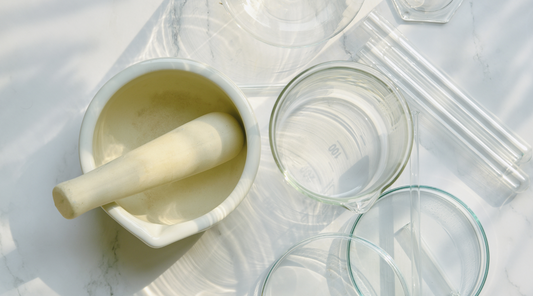Natural vs. Synthetic in Skincare: Is “All-Natural” Really Better (or Safer)?
Share
“Natural” sounds gentle. “Synthetic” can sound scary. But the truth is simpler (and more helpful): what matters is safety, concentration, stability, and evidence—not where an ingredient originated.
Why “natural” isn’t always better
Plenty of plant-derived ingredients work beautifully on skin, but they aren't automatically gentler or safer. What matters is how an ingredient behaves in a real formula.
Natural can still irritate.
Fragrant molecules found in many essential oils (like linalool and limonene) can become more sensitizing as they oxidize over time. Certain cold-pressed citrus oils can also make skin more sun-sensitive, which is why fragrance safety standards limit them or call for bergapten-free versions. And yes—tea tree oil is natural, and it can still trigger reactions in some people.[1][2][3][4]
Evidence matters as much as origin.
Plenty of botanicals have human data behind them (think colloidal oatmeal for calming, or licorice extracts for the look of dark spots). Others lean more on tradition than clinical studies. When you’re skimming claims, look for brands that reference the type of study or the concentration used, not just a trendy plant name.[5][6]
Processing and storage matter.
Which method is “better” depends on the plant and the goal. As a general guide, steam-distilled citrus oils tend to be less phototoxic than cold-pressed because distillation strips out many of the furocoumarins linked to sun sensitivity; cold-pressing keeps more of the whole-fruit compounds (including some you may not want in leave-on products). Freshness matters too: oxidized oils are more irritating than fresh ones, and base oils high in PUFA (polyunsaturated fatty acids) can go rancid faster. Smart formulas pair delicate oils with more stable lipids (like squalane or jojoba), add antioxidants, and use proper packaging (airless pumps, amber or frosted bottles).[3,7]
Eco-conscious doesn’t always mean “use the plant.”
Some aromatic crops face real sustainability pressure. Sometimes the lower-impact choice is responsibly sourced plant material; other times it’s a nature-identical alternative (a lab-made match to a molecule found in nature) that delivers the same scent or feel with far less land and water use.
Instead of “natural vs. synthetic,” the better question is at what concentration (and in what kind of formula) is it safe and effective?
Concentration is key (for natural and synthetic)
More doesn’t mean better. Every ingredient—plant-derived or lab-made—has an evidence-based effective range where it performs and stays comfortable on skin. Go above that range and irritation is more likely; go below it and you may not see much benefit. Smart formulas aim for those proven ranges and balance supporting ingredients so the product stays effective over time.
Ranges to look for
· Niacinamide (Vitamin B3, lab-made)
Most skin does well around 2–5% for barrier support and tone. Much higher can feel warm or look red on some skin.[8]
· AHAs (glycolic/lactic acids—often nature-derived)
Leave-on products typically sit around 5–10% for glow and smoothness. Above that is peel/clinic territory and can be too strong for everyday use.[9]
· Vitamin C formats (natural and lab-made derivatives)
L-ascorbic acid works best between 10–20% in low-pH water formulas but can sting and oxidize quickly. Tetrahexyldecyl ascorbate (THD, oil-soluble) is commonly used at ~3–10% in anhydrous or oil-rich bases. Many people find THD gentler and more stable in use; as always, results come down to the whole formula and packaging.[10-12]
Look for brands that share meaningful percentages (and pH when relevant) and that pair actives with a supportive base and protective packaging. More isn’t more—the right range in the right formula delivers the best results.
When the “synthetic” choice is the smarter one
Sometimes a lab-made or nature-identical ingredient is the safer, more stable, or more effective pick—especially in leave-on skincare.
· Ceramides — skin-identical barrier lipids
Lab-made, nature-identical ceramides match the ones your skin already uses to seal in moisture. Because they’re precisely defined (right chain lengths, high purity), they’re stable and consistent, and they slot neatly into barrier-supporting formulas, often more targeted than relying on heavier plant oils alone.[13-14]
· Panthenol (Pro-Vitamin B5) — comfort + hydration
Produced by synthesis or fermentation, panthenol converts on skin to vitamin B5. It draws and holds water, helps reduce the feeling of tightness, and plays nicely with other actives; it’s also low-odor and very stable, so you get dependable soothing without turning to higher-fragrance botanicals.[15]
· Squalane — cushion without the instability
A nature-identical, lab-refined version of skin’s own squalene (now commonly sourced via sugarcane or olives) is lighter and far more oxidation-resistant than many high-PUFA botanical oils, and stays fresher in formulas.[16]
How Bēm decides what goes in (and what stays out)
We evaluate safety, performance, and skin compatibility—not just origin—then layer in sustainability and transparency. Here’s why we skip certain categories, even if some are technically allowed at low levels by regulating bodies:
· Parabens: debated in the public and regulated differently by region; we use modern preservation systems instead.
· Phthalates: especially as undisclosed parts of “fragrance”, we prefer transparent, phthalate-free fragrance design.
· Sulfates: can be too stripping, so we opt for milder cleansing systems.
· Silicones & PEGs: we can achieve slip, spread, and stability with alternatives that better fit our eco and skin-feel goals.
· Mineral oil: we favor lighter emollients (like squalane) for a more breathable finish.
· Synthetic colorants: not needed for skin results; we keep formulas simple.
· Plastic microbeads: we don’t use solid microplastics due to environmental concerns and limited skincare upside; they’re already banned in many rinse-off cosmetics and restricted in the EU.[17-18]
We also avoid certain natural choices in leave-on formats when they’re more likely to irritate or raise sun-sensitivity:
· Fragrance levels: if we use scent, we keep it low and IFRA-compliant, and we’re transparent about known botanical allergens (like linalool or limonene) when present—so you always know what’s inside and can choose what works for your skin.[1-4]
· High-PUFA oils (like rosehip seed oil) as the main occlusives (we balance them with more stable lipids and antioxidants).
· “Drying” alcohols (e.g., alcohol denat./SD alcohol 40-B, isopropyl alcohol) used for “quick-dry” feel; we do use beneficial fatty alcohols like cetyl or stearyl for texture and barrier support.
Our north star: choose the best-fit ingredient—botanical or lab-made—when it’s proven, comfortable at the right concentration, and stable in the full formula.
Disclaimer
This post is for informational and educational purposes only. It’s not meant to treat, diagnose, or offer medical advice. Everyone's skin is unique, so we always recommend talking to a trusted dermatologist or healthcare provider before starting a new skincare routine—especially if you have specific skin concerns. All ingredient insights shared are based on publicly available research and clinical studies, which are cited throughout.
References
[1] https://dermnetnz.org/topics/contact-allergy-to-limonene-and-linalool [2] https://pubmed.ncbi.nlm.nih.gov/9165203/ [3] https://d3t14p1xronwr0.cloudfront.net/docs/standards/IFRA_STD_087.pdf [4] https://onlinelibrary.wiley.com/doi/full/10.1111/cod.12591?msockid=16539eb5aea9647306e488c4af846514 [5] https://pmc.ncbi.nlm.nih.gov/articles/PMC7103792/ [6] https://pmc.ncbi.nlm.nih.gov/articles/PMC3663177/ [7] https://ftp.cdc.gov/pub/Documents/OEL/06.%20Dotson/References/Karlberg_1992.pdf [8] https://pmc.ncbi.nlm.nih.gov/articles/PMC3142702/ [9] https://www.fda.gov/cosmetics/cosmetic-products/alpha-hydroxy-acids [10] https://www.health.harvard.edu/blog/why-is-topical-vitamin-c-important-for-skin-health-202111102635 [11] https://www.ncbi.nlm.nih.gov/pmc/articles/PMC10617894/ [12] https://www.ncbi.nlm.nih.gov/pmc/articles/PMC8395926/ [13] https://www.mdpi.com/2079-9284/6/3/52 [14] https://www.dovepress.com/skin-hydration-is-significantly-increased-by-a-cream-formulated-to-mim-peer-reviewed-fulltext-article-CCID [15] https://pmc.ncbi.nlm.nih.gov/articles/PMC7407203/ [16] https://www.cir-safety.org/sites/default/files/Squalene%20and%20Squalane.pdf [17] https://www.fda.gov/cosmetics/cosmetics-laws-regulations/microbead-free-waters-act-faqs [18] https://ec.europa.eu/commission/presscorner/detail/en/ip_23_4581

